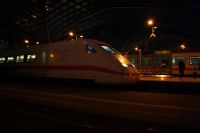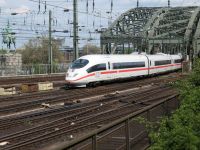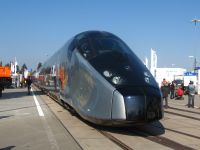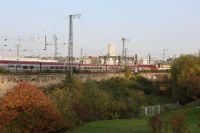California Proposition 1A
In California, in the context of the overall elections, there are several propositions for the people, one of them being Proposition 1A, which is all about providing money to build a Californian High-Speed Railway. Now, I don’t know much about californian politics, but I do know something about high-speed railways (same as every interested German), so I wanted to post some information here for Californians who might happen to land here.

Our High-Speed System
Just to put what I’m about to say into context: The German High-Speed System is the ICE, which is short for InterCity-Express. The special trainsets travel both on high-speed lines at speeds of up to 320 kph (200 mph) and on conventional lines at lower speeds. I think it’s safe to say that our system works pretty well most of the time, and world-wide, it does lag behind France and Japan in size, but technologically, we’re absolutely on the same level.
You may or may not already know that there is no speed limit on german freeways, and speeds of 160 kph (100 mph) are more than common here. Speeds of and exceeding 200 kph (125 mph) are found easily. The relevance of this is of course that this is quite some competition in the mere travel time department for trains.
It’s possible

First of all, straight up: There is no promise that the system can’t keep. San Francisco to LA in less than three hours will work, period. There’s nothing utopical about this, it’s all standard off-the-shelf technology. Speeds of and exceeding 320 kph (200 mph) are reached in France, Germany, Japan, Spain and probably others as well in normal scheduled operation. So it would be absolutely wrong to reject this on the grounds that this wasn’t proven technology or anything.
High speed is fast
That seems obvious, but again, keep in mind the speeds we (and I) tend to reach with cars here, which easily exceed twice of what is allowed at all in California. Alright, thanks to current gas prices I actually tend to drive a little slower, but there’s still a large gap between us and CA, and still, the speeds reached by ICEs remain absolutely competitive (at times better than with car, and never very far behind), even when used on conventional or slightly upgraded lines.
It’s cheaper

Admittedly, I have a Bahncard 50, which means I pay a lot of money every year (although being a student it’s actually not that much), and I get 50% off of every train journey I make in Germany. However, I fully expect similar programs to be available in California. While german gas prices are much higher than american ones, our cars are much more efficient, so it kind of evens out. All this considered, for me, taking the train is the cheaper alternative.
Convenience
Don’t get me wrong, I love my car and it offers great seats and air conditioning, which is really all I need to stay happy. However, in an ICE, I get a seat that’s about the same quality, only I can safely sleep in it, do work on my laptop, or get out and walk around the train (or use the toilet), and I don’t have to wear a seat belt. Railroads are simply far more convenient.
Competition to the Airplane

On first thought, the claim that a high-speed train could compete with a plane that flies twice as fast, but it actually can do so rather easily, since there’s no annoying check-in and security control times. Now, I wouldn’t even consider taking a plane on my routes, so I’m no expert here, but apparently I’m not alone: Airlines have cut prices on relations where high-speed train lines have opened, and not always with success. In fact, Air France/KLM is actually planning to replace flights between Paris and Amsterdam by new french high-speed trains of [Alstom AGV][agv] type.
Total Cost
One thing has to be admitted: It’s going to cost more and take longer than originally planned. Assuming anything else is delusional. There’s inflation, but there’s also issues such as environmental protection (a problem that is solved most easily by digging a tunnel under the area in question, which is expensive and takes time) and increased safety requirements. I still think it’s worth it’s money, but it’s a point to consider.
Economically

On the other hand, the claim that high-speed trains work out for their operators is absolutely true, which is great considering that this means less public money has to be put into the system. In fact, DB, the german railroad company, is more or less phasing out normal trains on long-distance lines and replaces them with ICEs, which are faster, more convenient and, most importantly, bring more money.
Written on October 30th, 2008 at 10:31 pm

 Deutsche Version
Deutsche Version